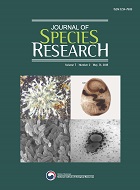Development of microsatellite markers to assess the genetic diversity of the red-tongue viper, Gloydius ussuriensis (Reptilia: Viperidae) on the Korean Peninsula
이무용 (국립수목원)
전희숙 (국립생물자원관)
도민석 (국립생물자원관)
구교성 (이화여자대학교)
Sang-Cheol Lee (Division of Life Sciences, Incheon National University)
정지화 (Division of Zoology, Honam National Institute of Biological Resources)
YoonJee Hong (국립생물자원관)
안정화 (국립생물자원관)
- 다운로드 수
- 조회수
Abstract
The red-tongue viper(Gloydius ussuriensis) is one of only three species of the genus Gloydius found in South Korea. Gloydius ussuriensis has a narrow activity radius and is distributed nationwide, and this species was reported to have the largest population among the Korean species in genus Gloydius. Preliminary results of a phylogenetic analysis using part of the mitochondrial DNA indicated that domestic G. ussuriensis is not comprised of monophyletic groups, and morphological analysis showed differences between domestic populations. In this study, we developed 17 microsatellites for the analysis of G. ussuriensis genetic diversity based on these characteristics. These microsatellites were developed using six multiplex panels, which could be employed to validate 80 G. ussuriensis specimens from different geographical regions in South Korea. The average number of alleles per locus was 12.2 and ranged from 4 to 25 alleles; the observed heterozygosity ranged from 0.238 to 0.950 and the expected heterozygosity ranged from 0.213 to 0.933. As a result of assessing four inland populations, a high level of genetic diversity was confirmed. These newly developed markers will be useful for further studies on the population structure and evolutionary history of the G. ussuriensis.
- keywords
- Gloydius ussuriensis, microsatellite marker, multiplex panel, population structure, red-tongue viper
- 다운로드 수
- 조회수
- 0KCI 피인용수
- 0WOS 피인용수


